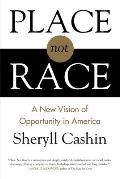
Place, Not Race: A New Vision of Opportunity in America
by Sheryll Cashin
Publisher Comments From a nationally recognized expert, a fresh and original argument for bettering affirmative action Race-based affirmative action had been declining as a factor in university admissions even before the recent spate of related cases arrived at the Supreme Court. Since Ward Connerly kickstarted a state-by-state political mobilization against affirmative action in the mid-1990s, the percentage of four-year public colleges that consider racial or ethnic status in admissions has fallen from 60 percent to 35 percent. Only 45 percent of private colleges still explicitly consider race, with elite schools more likely to do so, although they too have retreated. For law professor and civil rights activist Sheryll Cashin, this isn’t entirely bad news, because as she argues, affirmative action as currently practiced does little to help disadvantaged people. The truly disadvantaged—black and brown children trapped in high-poverty environs—are not getting the quality schooling they need in part because backlash and wedge politics undermine any possibility for common-sense public policies. Using place instead of race in diversity programming, she writes, will better amend the structural disadvantages endured by many children of color, while enhancing the possibility that we might one day move past the racial resentment that affirmative action engenders. In Place, Not Race, Cashin reimagines affirmative action and champions place-based policies, arguing that college applicants who have thrived despite exposure to neighborhood or school poverty are deserving of special consideration. Those blessed to have come of age in poverty-free havens are not. Sixty years since the historic decision, we’re undoubtedly far from meeting the promise of Brown v. Board of Education, but Cashin offers a new framework for true inclusion for the millions of children who live separate and unequal lives. Her proposals include making standardized tests optional, replacing merit-based financial aid with need-based financial aid, and recruiting high-achieving students from overlooked places, among other steps that encourage cross-racial alliances and social mobility. A call for action toward the long overdue promise of equality, Place, Not Race persuasively shows how the social costs of racial preferences actually outweigh any of the marginal benefits when effective race-neutral alternatives are available.
Trade Paperback

|
|
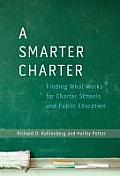
A Smarter Charter: Finding What Works for Charter Schools and Public Education
by Richard D. Kahlenberg and Halley Potter
Synopsis Moving beyond the debate over whether or not charter schools should exist, A Smarter Charter wrestles with the question of what kind of charter schools we should encourage. The authors begin by tracing the evolution of charter schools from teacher union leader Albert Shanker's original vision of giving teachers room to innovate while educating a diverse population of students, to today's charter schools where the majority of teachers are not unionized and student segregation levels are even higher than in traditional public schools. In the second half of the book, the authors examine two key reforms currently seen in a small but growing number of charter schools--teacher voice and socioeconomic integration--that have the potential to improve performance and reshape the stereotypical image of what it means to be a charter school. Important reading for policymakers, educators, researchers, and all citizens interested in the future of America's public schools, A Smarter Charter features: - Profiles of charter schools that are bucking the prevailing trends, including their performance data and the challenges they face.
- Best practices from successful charter schools, such as methods for attracting a diverse student body and examples of innovative teacher contracts.
- Reform strategies that can improve student outcomes in a variety of public schools, not just charters.
Hardcover

|
|
Public Housing and School Choice in a Gentrified City: Youth Experiences of Uneven Opportunity
by M. Makris
Publisher Comments Public Housing and School Choice in a Gentrified City is a case study of outside forces that influence the lives of low-income youth through education and housing policy. This multi-method study uses interviews, youth research, and case studies from Hoboken, New Jersey to examine the influence of district school choice and charter schools on the education of youth in public housing as well as on the environmental experiences of low-income youth in a gentrified community. Makris' research supports a link between school choice, universal preschool, and real estate, and shows that these educational policies are creating what Makris calls prolonged gentrification.
Your price $54.99
New Hardcover

|
|
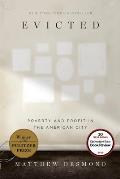
Evicted: Poverty and Profit in the American City
by Matthew Desmond
Publisher Comments
From Harvard sociologist and MacArthur “Genius” Matthew Desmond, a landmark work of scholarship and reportage that will forever change the way we look at poverty in America
In this brilliant, heartbreaking book, Matthew Desmond takes us into the poorest neighborhoods of Milwaukee to tell the story of eight families on the edge. Arleen is a single mother trying to raise her two sons on the $20 a month she has left after paying for their rundown apartment. Scott is a gentle nurse consumed by a heroin addiction. Lamar, a man with no legs and a neighborhood full of boys to look after, tries to work his way out of debt. Vanetta participates in a botched stickup after her hours are cut. All are spending almost everything they have on rent, and all have fallen behind.
The fates of these families are in the hands of two landlords: Sherrena Tarver, a former schoolteacher turned inner-city entrepreneur, and Tobin Charney, who runs one of the worst trailer parks in Milwaukee. They loathe some of their tenants and are fond of others, but as Sherrena puts it, “Love don’t pay the bills.” She moves to evict Arleen and her boys a few days before Christmas.
Even in the most desolate areas of American cities, evictions used to be rare. But today, most poor renting families are spending more than half of their income on housing, and eviction has become ordinary, especially for single mothers. In vivid, intimate prose, Desmond provides a ground-level view of one of the most urgent issues facing America today. As we see families forced into shelters, squalid apartments, or more dangerous neighborhoods, we bear witness to the human cost of America’s vast inequality—and to people’s determination and intelligence in the face of hardship.
Based on years of embedded fieldwork and painstakingly gathered data, this masterful book transforms our understanding of extreme poverty and economic exploitation while providing fresh ideas for solving a devastating, uniquely American problem. Its unforgettable scenes of hope and loss remind us of the centrality of home, without which nothing else is possible.
Your price $14.95
Used Hardcover

|
|
|
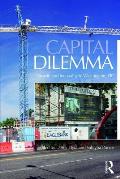
Capital Dilemma: Growth and Inequality in Washington, D.C.
by Hyra, Derek
Synopsis Capital Dilemma: Growth and Inequality in Washington, DC uncovers and explains the dynamics that have influenced the contemporary economic advancement of Washington, DC. This volume's unique interdisciplinary approach using historical, sociological, anthropological, economic, geographic, political, and linguistic theories and approaches, captures the comprehensive factors related to changes taking place in one of the world's most important cities. Capital Dilemma clarifies how preexisting urban social hierarchies, established mainly along race and class lines but also along national and local interests, are linked with the city's contemporary inequitable growth. While accounting for historic disparities, this book reveals how more recent federal and city political decisions and circumstances shape contemporary neighborhood gentrification patterns, highlighting the layered complexities of the modern national capital and connecting these considerations to Washington, DC's past as well as to more recent policy choices. As we enter a period where advanced service sector cities prosper, Washington, DC's changing landscape illustrates important processes and outcomes critical to other US cities and national capitals throughout the world. The Capital Dilemma for DC, and other major cities, is how to produce sustainable equitable economic growth. This volume expands our understanding of the contradictions, challenges and opportunities associated with contemporary urban development.
Your price $82.95
New Trade Paperback

|
|
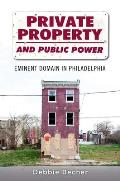
Private Property & Public Power Eminent Domain in Philadelphia
by Deborah Lynn Becher
Publisher Comments
News media reports on eminent domain often highlight outrage and heated protest. But these accounts, Debbie Becher finds, obscure a much more complex reality of how Americans understand property. Private Property and Public Power presents the first comprehensive study of a city's acquisitions, exploring how and why Philadelphia took properties between 1992 and 2007 for private redevelopment. Becher uses original data-collected from city offices and interviews with over a hundred residents, business owners, community leaders, government representatives, attorneys, and appraisers-to explore how eminent domain really works. Surprisingly, the city took over 4,000 private properties, and these takings rarely provoked opposition. When conflicts did arise, community residents, businesses, and politicians all appealed to a shared notion of investment to justify their arguments about policy. It is this social conception of property as an investment of value, committed over time, that government is responsible for protecting. Becher's findings stand in stark contrast to the views of libertarian and left-leaning activists and academics, but recognizing property as investment, she argues, may offer a solid foundation for more progressive urban policies.
Your price $54.50
New Trade Paperback

|
|
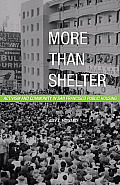
More Than Shelter: Activism and Community in San Francisco Public Housing
by Amy L. Howard
Publisher Comments In the popular imagination, public housing tenants are considered, at best, victims of intractable poverty and, at worst, criminals. More Than Shelter makes clear that such limited perspectives do not capture the rich reality of tenantsandrsquo; active engagement in shaping public housing into communities. By looking closely at three public housing projects in San Francisco, Amy L. Howard brings to light the dramatic measures tenants have taken to createandmdash;and sustain and strengthenandmdash;communities that mattered to them. More Than Shelter opens with the tumultuous institutional history of the San Francisco Housing Authority, from its inception during the New Deal era, through its repeated leadership failures, to its attempts to boost its credibility in the 1990s. Howard then turns to Valencia Gardens in the Mission District; built in 1943, the project became a perpetually contested and embattled space. Within that space, tenants came together in what Howard calls affective activismandmdash;activism focused on intentional relationships and community building that served to fortify residents in the face of shared challenges. Such activism also fueled cross-sector coalition building at Ping Yuen in Chinatown, bringing tenants and organizations together to advocate for and improve public housing. The account of their experience breaks new ground in highlighting the diversity of public housing in more ways than one. The experience of North Beach Place in turn raises questions about the politics of development and redevelopment, in this case, Howard examines activism across generationsandmdash;first by African Americans seeking to desegregate public housing, then by cross-racial and cross-ethnic tenant groups mobilizing to maintain public housing in the shadow of gentrification. Taken together, the stories Howard tells challenge assumptions about public housing and its tenantsandmdash;and make way for a broader, more productive and inclusive vision of the public housing program in the United States.
Trade Paperback

|
|
Price of Inequality How Todays Divided Society Endangers Our Future
by Joseph E Stiglitz
Publisher Comments
America currently has the most inequality, and the least equality of opportunity, among the advanced countries. While market forces play a role in this stark picture, politics has shaped those market forces. In this best-selling book, Nobel Prize-winning economist Joseph E. Stiglitz exposes the efforts of well-heeled interests to compound their wealth in ways that have stifled true, dynamic capitalism. Along the way he examines the effect of inequality on our economy, our democracy, and our system of justice. Stiglitz explains how inequality affects and is affected by every aspect of national policy, and with characteristic insight he offers a vision for a more just and prosperous future, supported by a concrete program to achieve that vision.
Your price $9.95
Used Trade Paperback

|
|
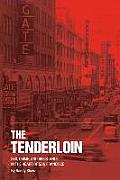
Tenderloin Sex Crime & Resistance in the Heart of San Francisco
by Randy Shaw
Publisher Comments
America once had many Tenderloin neighborhoods. Today, San Francisco’s Tenderloin is the last. Surrounded by Union Square’s posh retailers to the north, upscale Hayes Valley to the west and the Twitter/Mid-Market tech scene and affluent SOMA to the south, San Francisco’s Tenderloin remains a primarily low-income, ethnically diverse neighborhood in a city of vast wealth. How has it survived?
Randy Shaw answers this question in his long awaited new book, The Tenderloin: Sex, Crime and Resistance in the Heart of San Francisco. Shaw, who has worked in the Tenderloin for 35 years and published four prior books including The Activist’s Handbook, traces the mystery of the Tenderloin’s survival from its post-quake rebuilding in 1907 through today. What he discovers challenges longstanding assumptions about urban neighborhoods. Not only does the Tenderloin show that residents can act to avoid the “inevitability” of urban gentrification, but also that low-income communities can enjoy the benefits of neighborhood improvements without these becoming a harbinger of displacement.
The Tenderloin is a must read for anyone concerned about the future of urban neighborhoods. It offers a new model and roadmap for neighborhood improvement that defies common assumptions about how big cities can maintain economic diversity in the 21st Century.
Named for a part of the city where bribes bought police the highest-grade beef, San Francisco’s Tenderloin is the last of many such neighborhoods once found across the United States. Shaw shows that for nearly a century the Tenderloin has fought against the establishment time and time again. And often won. Shaw shows how those outside the mainstream—independent working women, gay men, “screaming queens” activist SRO hotel tenants and many others—led these struggles. Once known for “girls, gambling and graft,” the Tenderloin was also fertile ground for the Grateful Dead, Miles Davis, Dashiell Hammett and other cultural icons. The Tenderloin is the untold story of a neighborhood that persisted against all odds. It is a must read for everyone concerned about the future of urban neighborhoods
Trade Paperback

|
|